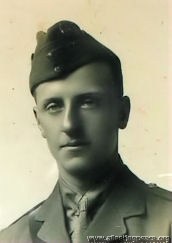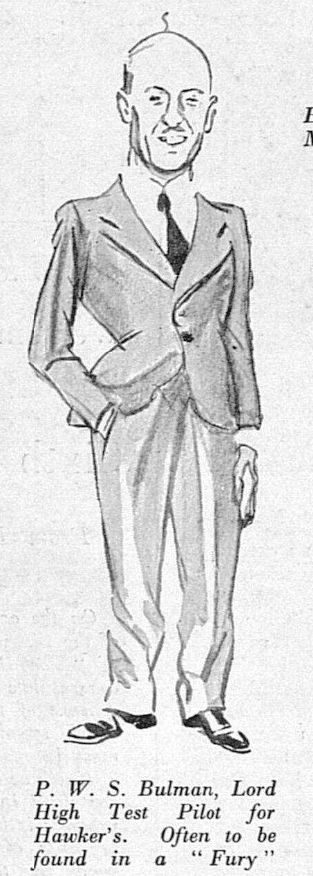|
Maj (later Flt-Lt) Paul Ward Spencer 'George' Bulman CBE MC AFC
|
||
|
Universally known as 'George'; after WWI, test pilot at RAE Farnborough until 1925, then chief test pilot at Hawker Aircraft, where he took over from 'Fred' Raynham.
It was at his instigation that the Hurricane was fitted with a variable-pitch propeller, "The improvement in performance was so impressive that the result was a panic of refitting of airscrews, and the effect on the outcome of the Battle of Britain can be imagined." Harald Penrose said he was "a great little man, eager yet cool, eyes crinkled in a smile, bald head gleaming as he climbed helmetless into the cockpit". d.1963
Britain's Test Pilots Flight, 4th April 1946: “GEORGE” BULMAN might never have been known in the aircraft industry had he continued at his original occupation. In fact, he would have been more nationalized than he is now, because he started his business career in the Bank of England. Perhaps that is where he got his meticulous attention to detail. Group Capt. Bulman is seldom known by his proper Christian name Paul, and it is interesting to learn how he ever came to be known universally as "George." He always confessed to a shocking memory for names, and during the 1914-18 war addressed almost everyone as "Colonel" or "General." When peace came, a civil edition had to be found, and his friends and acquaintances became Georges. They, in their turn, called him "George" Bulman. A little more than a year before the Royal Flying Corps became the Royal Air Force in April, 1918, Bulman learnt to fly on a "Rumpety" (Maurice Farman Longhorn) of No. 4 Reserve Squadron at Northolt. Previous to this he had been in the Honourable Artillery Company, but was dead keen to become a motor cyclist despatch rider. A motor-cycling friend, however, managed to persuade him that flying was the thing really worth doing, and got him transferred to the R.F.C. After his training, "George” was with fighters exclusively. First in No. 46 Squadron under Major (now Air Marshal, retired) Philip Babington, flying Sopwith Pups and then with No. 3 Squadron, when it changed over to Sopwith Camels. He went to No. 3 as a fighter expert, and in the fighting at Courtrai these tiny Camels—carrying four 20lb bombs each—operated with the tanks. This was the birth of the operations by Typhoons, the direct descendants of the Camel, in the Falaise Gap in the Battle of Normandy nearly 30 years later. It is impossible to get Bulman to talk about his deeds in the 1914-18 war. He was heard to let it slip on one unguarded occasion that he was a bloodthirsty young man, but farther than that he never goes. Asking how many enemy aircraft he got to his credit always brings the same answer: ''We flew as a Flight, and did no individual operations. All victories belonged to the Flight.” Nevertheless, he was awarded the Military Cross for his share. First Test Work At the close of hostilities in1918 he was granted a permanent commission, and almost immediately took up his first test flying. He was posted to the Daimler airfield at Radford, where Sopwith Snipes and S.E.5AS were produced, and shortly afterwards went to the ferry pool in the Midlands at Castle Bromwich. Here experience on twin-engined types was gained as the unit had to test and ferry D.H.10s (made by the Birmingham Carriage Co.) and Handley Page 0/400s. It was because of his work here that he came to take up test flying as a permanent occupation. There happened to be a number of one-engined failures on the D.H.10s which had caused some loss of life among the ferry pilots. "Farnborough“ was investigating the trouble, and "George" took one to Farnborough to replace a crash. He had found the trouble in the petrol system, and the outcome of a talk on this with Roderic Hill (now Air Marshal Sir Roderic) resulted in an invitation to join Farnborough. That was in 1919. His test flying at the R.A.F. dealt exclusively with engines, and the period between 1919 and 1925 proved to be a fascinating one ; as he puts it,'' ironing out the bugs of the air cooled radial engine." The team with whom he worked took the radial out into the world. While at Farnborough he did a certain amount of testing for Blackburns, and, among other types, flew the Cubaroo, Blackburn, Beagle and Airedale. In view of the development to-day in helicopters, it is interesting to remember that 20 years ago, at Farnborough, he flew the Brennan helicopter, which had all the basic elements of the successful modern types. It was flown while partially moored in the old balloon shed. About 1924 there came into existence the R.A.E. Aero Club, of which Oliver Simmonds (now Sir Oliver of Aerocessories) was the secretary, Mr Child the designer, and Bulman the chairman and competition pilot. A monoplane—the Hurricane—with triangular-section fuselage, was built by the members and fitted with a horizontally opposed engine, first a 600 c.c. Douglas motorcycle engine and later a 30 h.p. Bristol Cherub. This contraption nearly wrote "George" off. Vibration from the twin-cylinder engine was prone to shut the petrol off because the cock employed was one of the very ordinary "slide with a hole in it" models common to motor bicycles. This cock was under the dash and was critical of its setting. Imagine, then, the juggling required when the engine and airscrew stopped dead at 800ft. over Redhill while flying from Farnborough to Lympne for the competitions. He had to dive nearly vertically to get sufficient airspeed to force the engine over compression—no small task with a two-cylinder engine—and at the same time search under the dashboard for the petrol cock. The engine picked up with no height to spare. Display Flying Pilots who could fly as exquisitely as Bulman were very much in demand for the Royal Air Displays, which were then held on the last Saturday in June each year. Since he was already doing odd jobs for Hawkers, and was thes ervice pilot deputed to fly the Hawker Woodcock in 1924,it was natural that he and the Hawker people became well acquainted, with the result that in 1925 he resigned his commission and joined the company. The Horsley was being flown at the time, and Bulman took over the Mark I from Fred Raynham who was one of the very old stagers. Raynham was, I think, the only man who ever had a joystick break off in his hand and have to land the machine (a Handley Page monoplane) by the small socket at the base, letting go every second or so to look over the side to see where he was going. "George" did all the test flying on the Horsley II, including preparing it for thel ong-distance record, which it held for a few hours in 1927 by flying from Cranwell to Jask in the Persian Gulf. It was beaten the next day by Lindbergh flying from NewYork to Paris. If any pilot to-day thinks he is flying an overloaded aircraft let him remember that when the Horsley was filled with fuel ready for the record, it burst its tyres just standing on the tarmac! Starting with the Heron and Hornbill, Bulman was responsible for test-flying all the Hawker prototypes right up to and including the Hurricane. The Fury (biplane) and Hart days were the days he loved. He worked like a Trojan turning good designs into super-good flying aircraft. This good test-flying, allied to his technical knowledge and charm of manner, undoubtedly played a big part in bringing the Hawker concern to the pre-eminence which it now enjoys. Having got Philip Lucas to take on development flying of types later than the Hurricane, Bulman went to the U.S. in May, 1941, as Chief of the Test Branch of the British Air Commission. He had a team of 10 or 11 pilots with him, and they flew all the types of aircraft on order for the British Government, making out flight-test reports on the Boscombe Down pattern. At first this was a civilian job, but after America came into the war he wore uniform and was promoted to Group Captain. Compressibility Recognised It was whilst he was in America that Bulman realised that the peculiar happenings which test pilots were reporting were just what the scientists had foretold would happen when speeds in the region of that of sound were approached. Much experimental work was carried out on the Lockheed Lightning, and Bulman devised a method of flying whereby the effects could be intensified or diminished safely and at will. His notes to test pilots on the subject show a clear-cut appreciation of the problem, and he probably has more practical knowledge on the subject than anyone else. According to Bulman, his test pilot's life was almost devoid of incident—certainly he was always careful to study everything on the ground before taking off—but he has had one or two close shaves. For instance, when he was flying the Leopard-engined Horsley to Denmark, he had a con-rod break over Heligoland. Landing in Germany was forbidden. So, finding that the engine would run at full throttle (imagine the vibration and racket) he flew to Groningen in Holland and landed there. The inside of that engine was a marvel to behold! And here is a story told for the first time. I have had it filed away in a drawer for years. At a Household Brigade Club meeting at Hatfield "George" put up a remarkable show. To the spectators it appeared as if he climbed vertically to 3,500ft, stopped his airscrew and then, flicking into a vertical dive, regained his engine as he pulled out at no feet. What really happened was that he accidentally gave the Hart a little negative g at the top of the climb and this emptied the Kestrel's carburettor. From the wealth of his experience he remembered that an airscrew will start in a pull-out at 3 or 4g even when it refuses to do so in a straight dive. After twenty years' service with the Hawker Company, he gave up the directorship which he had held since 1936, and is now taking a well-earned rest before coming back into the industry. But before leaving '' George '' to sit back for a while, let me quote one more case of how an enthusiastic man can get done a job which has far-reaching results. In 1938 all the Hurricanes had fixed-pitch airscrews, and no official sanction could be got for anything else. Bulman scrounged a Hurricane off contract and got de Havillands to collaborate by putting in a two-speed airscrew. He then borrowed a c.s. governor from the Hamilton Standard Corporation in America. The improvement in performance was so impressive that the result was a panic of refitting of airscrews, and the effect on the outcome of the Battle of Britain can be imagined. |


 photo: 1917, when a 2nd Lieutenant in the RFC
photo: 1917, when a 2nd Lieutenant in the RFC The Bystander Special Aviation Edition, 1933
The Bystander Special Aviation Edition, 1933 seated in a prototype Hurricane c.1946
seated in a prototype Hurricane c.1946